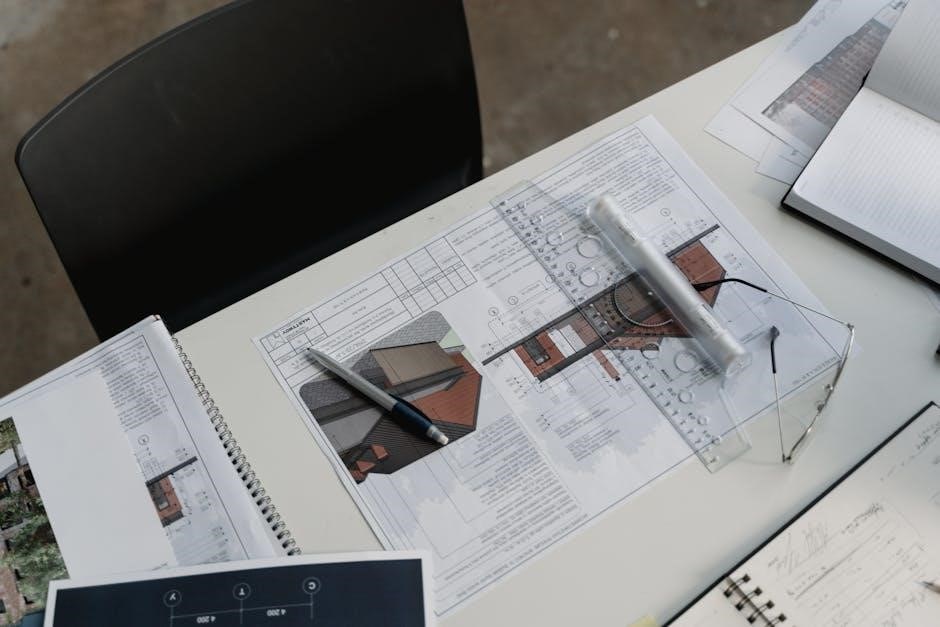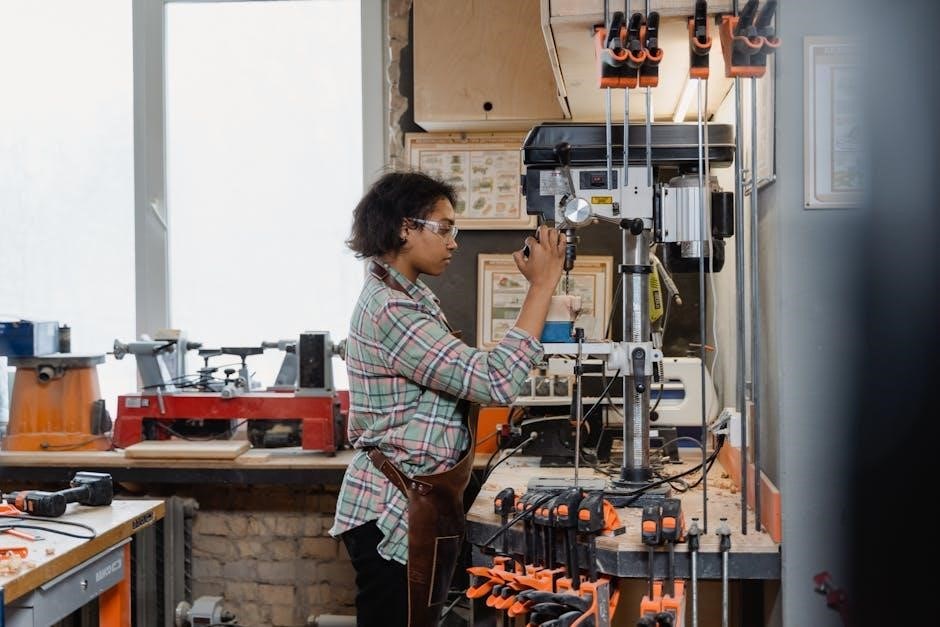Table saw station plans provide comprehensive guides for building efficient workstations, enhancing productivity and safety in woodworking projects. These designs cater to various workshop sizes, offering customizable solutions for optimal tool integration and workspace utilization. Explore detailed instructions for constructing versatile stations tailored to your needs, from basic setups to advanced configurations.
What is a Table Saw Station?
A table saw station is a customized workstation designed to integrate a table saw with additional features like storage, outfeed support, and tool integration. It enhances productivity by providing a stable, ergonomic workspace for cutting and processing wood. These stations can be mobile or stationary, often built from wood or metal, and are tailored to fit specific workshop needs. They typically include features like extended work surfaces, dust collection systems, and storage compartments for accessories. The primary goal of a table saw station is to improve accuracy, safety, and efficiency while woodworking. Many plans are available online, offering step-by-step instructions to build these workstations, catering to both small and large workshops. They are ideal for woodworking enthusiasts seeking to maximize their tool’s potential and streamline their workflow.
Why Build a Table Saw Station?
Building a table saw station enhances your woodworking experience by providing a stable, ergonomic, and organized workspace. It improves safety by minimizing kickback risks and offering better control over materials. A dedicated station increases efficiency by keeping tools and accessories within easy reach, reducing setup time for projects. Customization options allow you to tailor the design to your specific needs, such as adding storage for blades or integrating a router table. Additionally, a well-designed station can save space, especially in smaller workshops, by combining multiple functions into one unit. Investing time in building a table saw station pays off by streamlining your workflow, boosting productivity, and ensuring precise cuts. With numerous plans available, you can create a workstation that perfectly complements your table saw and elevates your woodworking capabilities.

Benefits of a Table Saw Station
A table saw station enhances productivity, offering a versatile workspace for precise cuts and efficient workflows. It maximizes workshop space, ensures stability, and supports customizable designs tailored to specific needs.
Improved Safety
A well-designed table saw station significantly enhances safety by providing a stable and secure workspace for operations. Features like zero-clearance inserts and proper alignment reduce kickback risks and prevent material from binding.
Integrated safety accessories, such as featherboards and push sticks, ensure hands remain away from the blade. Additionally, a dedicated station minimizes clutter, reducing tripping hazards and improving visibility.
By maintaining a clean and organized workspace, you can focus on precise cuts, lowering the chance of accidents. These designs prioritize user protection, making them essential for safe and efficient woodworking.
Increased Work Surface Area
A table saw station expands your work surface, making it easier to handle large materials and complex projects. Extensions and folding tables provide additional space for cutting and assembling.
With a dedicated station, you can rip long panels or manage multiple pieces simultaneously, enhancing workflow efficiency. Modular designs allow for customization, ensuring the workspace adapts to your specific needs.
This extra surface area reduces the need for temporary supports, minimizing clutter and improving precision. Whether you’re working on furniture or construction projects, a larger work area streamlines your process and delivers professional results.
Enhanced Storage Options
Table saw station plans often include innovative storage solutions to keep your workshop organized. Built-in shelves, cabinets, and drawers provide ample space for tools, blades, and accessories.
Many designs feature compartments specifically for storing saw blades, fence systems, and push sticks, ensuring everything is within easy reach. Some plans also incorporate hooks for hanging accessories like measuring tapes or safety gear.
Mobile stations with foldable designs allow for efficient use of space while maintaining storage capacity. Customizable compartments and adjustable shelving cater to individual preferences, making it easier to maintain a clutter-free workspace.
By integrating storage into your table saw station, you can optimize your workshop layout, reduce wasted time searching for tools, and enhance overall productivity. These practical storage solutions are a key benefit of well-designed table saw stations.

Choosing the Right Plan
Selecting the right table saw station plan involves assessing your workshop space, tool requirements, and storage needs. Consider designs that offer flexibility, customization, and compatibility with your tools.
Factors to Consider
When selecting a table saw station plan, consider workshop space, tool compatibility, and storage needs. Assess the mobility requirements, as some plans offer foldable or mobile designs, ideal for small spaces. Durability and material choice are crucial for long-term performance. Ensure the plan aligns with your skill level, whether beginner-friendly or advanced. Budget is another key factor, as plans vary in cost and complexity. Additionally, think about integration with other tools, like routers or miter saws, to maximize functionality. Finally, evaluate the plan’s adaptability to future upgrades or modifications, ensuring it grows with your woodworking needs and skills.
Popular Types of Plans
Popular table saw station plans include mobile and foldable designs, ideal for small workshops or those needing versatility. Rolling workbenches with integrated storage are also favored, offering convenience and space efficiency. Some plans feature dual-functionality, combining table saws with router tables or miter saws for enhanced versatility. Compact, wall-mounted stations are another trend, maximizing limited space while maintaining functionality. Additionally, there are plans that focus on outfeed support and custom storage solutions, catering to specific woodworking needs. These designs ensure that users can choose a plan that fits their unique workshop setup and woodworking goals, providing both practicality and efficiency in their projects.
Free vs. Paid Plans
When exploring table saw station plans, users often weigh the benefits of free versus paid options. Free plans are excellent for beginners or those on a budget, offering basic designs that can be customized. They provide a foundation for building functional workstations, though they may lack detailed instructions or advanced features. Paid plans, on the other hand, deliver comprehensive guides with precise measurements, materials lists, and step-by-step tutorials. They often include bonus features like 3D models, video tutorials, and customer support. For those seeking intricate designs or professional-grade workstations, paid plans are a worthwhile investment. Both options allow users to enhance their workshops, but the choice depends on their skill level, project complexity, and desired outcomes.

Design Considerations
Designing a table saw station requires careful planning to optimize functionality, safety, and space. Consider integrating storage, tool compatibility, and ergonomic features for a practical workspace.
Space-Saving Solutions
Maximizing workshop space is essential, and table saw station plans often include clever designs to save room. Foldable wings, collapsible extensions, and vertical storage options are popular features. Mobile bases allow the station to be moved out of the way when not in use, while compact layouts ensure minimal footprint. Some designs incorporate multi-functional components, such as built-in router tables or storage compartments, to reduce clutter. For small workshops, these space-saving solutions are crucial for maintaining efficiency without sacrificing functionality. Plans often include step-by-step guides for building foldable or modular stations that adapt to limited areas. By integrating practicality and innovation, these designs help woodworkers make the most of their available space while keeping tools accessible and organized. This approach ensures a seamless workflow even in tight workshops.
Integration with Other Tools
Effective table saw stations often incorporate integration with other essential woodworking tools, enhancing workflow and efficiency. Many plans include designs for combining the table saw with routers, miter saws, or sanders into a single, cohesive workstation. This multi-tool setup allows for seamless transitions between tasks, reducing the need for additional floor space. Some designs feature sliding drawers or compartments to house accessories like blades, inserts, and jigs, keeping them within easy reach. Advanced configurations may include dust collection systems to maintain a clean environment. By integrating multiple tools into one station, woodworkers can streamline their processes, improve accuracy, and complete projects more efficiently. These versatile setups are particularly beneficial for small workshops where space and organization are critical. This approach ensures that all necessary tools are conveniently accessible, fostering a more productive workspace.
Aesthetic and Functional Design
Aesthetic and functional design is crucial for table saw stations, ensuring they are both visually appealing and practical. Many plans emphasize clean lines, durable materials, and finishes that blend seamlessly with workshop environments. Functionality is prioritized through ergonomic layouts, ensuring easy access to tools and materials. Some designs incorporate foldable or collapsible elements to save space while maintaining a sleek appearance. Optional features like built-in lighting or electrical outlets enhance usability without compromising the design. Customizable storage solutions, such as drawers or shelves, keep the workspace organized and clutter-free. These designs balance form and function, offering long-term durability and timeless appeal for woodworkers. Whether for small or large workshops, these stations are crafted to be both efficient and visually satisfying, creating a professional-grade workspace.

Building Your Table Saw Station
Constructing a table saw station involves precise planning and execution, using high-quality materials for durability and functionality. Start with a sturdy frame, ensuring stability and alignment. Add a smooth work surface, integrate essential tools, and incorporate storage solutions. Follow detailed plans to achieve professional results, ensuring safety and efficiency in your woodworking projects. Each step, from assembly to final touches, requires careful attention to create a workstation that enhances your workshop’s productivity and organization.
Essential Tools and Materials
Building a table saw station requires a combination of durable materials and essential tools to ensure stability and functionality. Start with high-quality lumber, such as 2x4s or 3/4-inch plywood, for the frame and work surface. Reinforce the structure with wood screws, bolts, and wood glue for added strength. A table saw is obviously central to the project, but additional tools like drills, sanders, and clamps are crucial for precise cuts and assembly. Don’t forget safety gear, including push sticks and featherboards, to prevent accidents. For mobility, incorporate casters or wheels, and consider adding T-tracks for custom fences or jigs. Finally, include storage solutions like drawers or shelves to keep accessories organized. Having these tools and materials on hand ensures your table saw station is both durable and functional.
Step-by-Step Construction Process
Begin by assembling the base frame using pre-cut lumber, ensuring it is square and level. Attach the table saw to the frame, aligning it perfectly with the work surface. Next, add the top surface, typically made of durable plywood or MDF, and secure it with screws. Install the fence system, ensuring it is parallel to the blade for accurate cuts. Add support brackets for outfeed and side tables if included in your design. Check all alignments and tighten any loose connections. Finally, sand the entire structure for a smooth finish and apply a protective coat of paint or varnish. Follow the plan closely, and test the station with a few practice cuts to ensure everything functions properly before full use.
Common Mistakes to Avoid
One of the most critical mistakes when building a table saw station is improper alignment of the saw with the work surface, leading to inaccurate cuts. Ensure the blade is parallel to the fence and the table is level. Another common error is mismeasuring materials, which can result in a poorly fitting frame or uneven surfaces. Always double-check measurements before cutting lumber. Neglecting to test the station before full use is another oversight; make trial cuts to identify and fix any issues. Additionally, ignoring safety features, such as proper dust collection or fence installation, can compromise functionality and safety. Finally, rushing the construction process can lead to a structurally unsound station. Take your time and follow the plans meticulously to avoid these pitfalls and ensure a sturdy, functional workstation.

Advanced Features
Enhance your table saw station with features like outfeed support for handling large materials, folding capabilities for space-saving convenience, and custom storage solutions to keep tools organized.
Outfeed Support
Outfeed support is essential for handling large materials and ensuring precise cuts. It provides a stable surface for long boards or sheets, preventing warping and improving workflow. Many plans include folding or extendable outfeed tables that save space while offering robust support. These designs often feature adjustable legs and durable materials to withstand heavy use. Some advanced setups integrate dual support arms or roller systems for seamless material handling. Outfeed support enhances safety by keeping the workpiece flat and secure, reducing the risk of kickback. When building your station, consider adding a dust collection port near the outfeed area to maintain a clean workspace. With proper outfeed support, you can tackle demanding projects with confidence and accuracy, making it a vital feature for any table saw station.
Folding and Mobile Capabilities
Folding and mobile capabilities are ideal for workshops with limited space, allowing easy reconfiguration and storage. These designs often feature collapsible wings or foldable tables that minimize footprint when not in use. Mobile bases with casters enable easy relocation, while locking mechanisms ensure stability during operation. Some plans incorporate multi-functional elements, such as built-in storage compartments or tool holders, to maximize efficiency. Folding capabilities are particularly useful for handling large panels, as they provide additional support without permanent space dedication. Advanced designs may include quick-release mechanisms for rapid setup and takedown. By integrating mobility and folding features, you can optimize your workspace, enhance flexibility, and adapt your table saw station to meet various project demands efficiently.
Custom Storage Solutions
Custom storage solutions are a key feature in many table saw station plans, allowing you to organize tools, accessories, and materials efficiently. These designs often include built-in shelves, drawers, or compartments tailored to specific needs, such as blade storage or dust collection components. Some plans incorporate fold-out compartments or slide-out drawers for easy access, while others utilize vertical space with wall-mounted cabinets. Adjustable shelves and modular systems enable flexibility, accommodating various tool sizes and types. These storage solutions not only keep your workspace clutter-free but also enhance productivity by ensuring everything is within reach. By integrating custom storage into your table saw station, you can maximize space, reduce workflow interruptions, and maintain a well-organized workshop environment.

Customizing Your Station
Customizing your table saw station allows you to tailor it to your specific woodworking needs, ensuring optimal functionality and efficiency. From upgraded fences to integrated router tables, these modifications enhance precision and versatility, making your workstation truly unique and adaptable to various projects. Personalized adjustments and additions ensure your station evolves with your skills and workshop demands.
Upgrading the Fence System
Upgrading the fence system on your table saw station is a crucial enhancement for improving accuracy and ease of use. A high-quality fence ensures precise cuts by maintaining consistent alignment with the blade. Consider installing a T-track or extruded aluminum fence for durability and smooth operation. Micro-adjustable fences allow for fine-tuning, reducing errors and boosting productivity. Additionally, adding a sacrificial fence or auxiliary fence can protect your main fence from damage during complex cuts. Many plans include designs for custom fences tailored to specific woodworking needs. Upgrading the fence system not only enhances performance but also integrates seamlessly with other workstation features, such as router tables or dust collection systems. This customization ensures your table saw station remains versatile and adaptable to various projects, making it a central hub for efficient woodworking.
Adding a Router Table
Integrating a router table into your table saw station enhances versatility, allowing for precision routing and edge profiling. Many plans offer designs for a built-in router table, often with a sliding drawer mechanism for easy access. This setup enables seamless transitions between sawing and routing tasks, saving time and workspace. Consider a multi-functional design where the router table can be quickly swapped with the saw, maintaining a compact footprint. Custom storage solutions for router bits and accessories keep your workshop organized. Adding a router table transforms your station into a multi-purpose woodworking hub, perfect for small shops or hobbyists seeking to maximize their tool efficiency. This integration ensures your workspace remains efficient and adaptable to various woodworking projects.
Incorporating Dust Collection
Incorporating a dust collection system into your table saw station is essential for maintaining a clean and safe workspace. Many plans include designs for integrating a vacuum or dust collector directly into the station, ensuring efficient debris removal during cuts. This feature not only improves air quality but also reduces the risk of kickback and enhances cutting accuracy. Some designs offer under-table dust collection bins or centralized systems that connect to both the table saw and router. Properly sealing gaps and aligning ductwork ensures maximum efficiency. Additionally, storage compartments for dust collection accessories, like filters and hoses, keep your workspace organized. A well-integrated dust collection system elevates your table saw station’s functionality, making it a central hub for efficient and dust-free woodworking operations.

Safety Tips and Best Practices
Always use push sticks and featherboards for control, ensure proper fence alignment, and maintain a clean workspace. Regularly inspect blades and accessories for damage or wear.
Proper Setup and Alignment
Proper setup and alignment are crucial for safe and accurate cuts. Ensure the table saw blade is parallel to the fence to prevent kickback. Regularly check the miter slots for alignment with the blade, as misalignment can lead to uneven cuts. Calibrate the fence system to maintain consistency, and verify the blade’s squareness to the table. Use precision tools like combination squares and dial indicators for accurate adjustments. Before cutting, inspect the table surface for debris and ensure all accessories are securely locked in place. Proper setup not only enhances safety but also improves the quality of your woodworking projects. Always refer to your table saw station plans for specific alignment instructions tailored to your design.
Essential Safety Accessories
Essential safety accessories for your table saw station are vital to prevent accidents and ensure smooth operations. A push stick or fence is crucial for guiding wood safely through the blade, reducing the risk of kickback. Featherboards help maintain consistent pressure against the fence, preventing material from shifting during cuts. Splitters or riving knives are indispensable for keeping the wood from closing on the blade, minimizing kickback hazards. Dust collection systems are another key accessory, as they reduce airborne particles, improving visibility and workshop safety. Additionally, safety glasses, hearing protection, and a first aid kit should always be within reach. Ensure all accessories are compatible with your table saw model and properly installed. Regular maintenance and adherence to manufacturer guidelines will further enhance safety standards in your workshop.
Maintenance for Optimal Performance
Regular maintenance is crucial for ensuring your table saw station operates at peak performance. Start by lubricating moving parts, such as the blade elevation and tilt mechanisms, to prevent rust and wear. Check and tighten all bolts and screws periodically, especially after heavy use. The table top should be cleaned and waxed to maintain a smooth surface, reducing friction during cuts. Inspect the blade for dullness or damage and replace it as needed. Dust collection systems should be emptied and filters cleaned to maintain airflow efficiency. Additionally, align the fence and blade regularly to ensure accurate cuts. Proper storage of tools and accessories when not in use will also prolong the lifespan of your station. By following these maintenance steps, you can extend the durability and functionality of your table saw station, ensuring consistent results for all your woodworking projects. Proper upkeep not only enhances performance but also safeguards against potential safety hazards, making regular maintenance a critical part of owning a table saw station.

Additional Resources
Explore recommended websites for detailed plans, instructional videos for step-by-step guidance, and community forums for expert advice and user discussions on building table saw stations.
Recommended Websites for Plans
For detailed table saw station plans, visit websites like Ana White and Woodsmith Plans. These sites offer a wide range of free and paid plans, including step-by-step instructions, materials lists, and diagrams. Ana White’s rolling workbench system is a popular choice for workshop storage and functionality. Woodsmith Plans provides advanced designs, such as a compact table saw workstation with router table integration. Both platforms cater to DIY enthusiasts and professionals alike, ensuring you find a plan that fits your workshop size and needs. Additionally, these websites often include video tutorials and community forums for support, making your building process easier and more efficient. Explore these resources to find the perfect plan for your table saw station project;
Instructional Videos and Tutorials
Instructional videos and tutorials are invaluable resources for building a table saw station. Websites like YouTube and woodworking forums offer step-by-step guides, ensuring clarity and precision. For instance, Ana White provides detailed video tutorials for her roll-away workbench system, while Woodsmith Plans offers instructional content for compact workstations. These videos often include tips for customization, such as adding a router table or improving outfeed support. Additionally, platforms like YouTube feature DIY enthusiasts sharing their own builds, offering unique ideas and solutions. These tutorials are perfect for both beginners and experienced woodworkers, covering everything from initial setup to advanced modifications. They also emphasize safety practices, ensuring your project is both functional and secure. Utilize these resources to bring your table saw station plans to life with confidence and precision.
Community Forums and Groups

Community forums and groups are excellent resources for discussing table saw station plans and sharing ideas. Platforms like Reddit’s r/woodworking and specialized woodworking forums offer spaces to ask questions, share progress, and gather feedback. Many DIY enthusiasts and professionals actively participate, providing valuable insights and tips. These communities often feature threads dedicated to table saw stations, where users showcase their builds and offer advice. Additionally, groups on Facebook and LinkedIn connect woodworkers globally, fostering collaboration and innovation. Websites like The Handymans Daughter and Woodsmith Plans also host forums where users can discuss their projects and seek guidance. Engaging with these communities can help troubleshoot challenges, inspire creativity, and refine your table saw station design. Active participation in these groups ensures you stay updated on the latest trends and techniques in woodworking.




Leave a Reply
You must be logged in to post a comment.